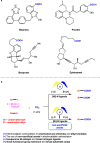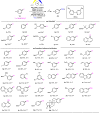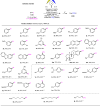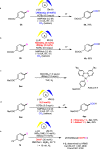Nickel-catalyzed electrochemical carboxylation of unactivated aryl and alkyl halides with CO2
- PMID: 34873172
- PMCID: PMC8648755
- DOI: 10.1038/s41467-021-27437-8
Nickel-catalyzed electrochemical carboxylation of unactivated aryl and alkyl halides with CO2
Abstract
Electrochemical catalytic reductive cross couplings are powerful and sustainable methods to construct C-C bonds by using electron as the clean reductant. However, activated substrates are used in most cases. Herein, we report a general and practical electro-reductive Ni-catalytic system, realizing the electrocatalytic carboxylation of unactivated aryl chlorides and alkyl bromides with CO2. A variety of unactivated aryl bromides, iodides and sulfonates can also undergo such a reaction smoothly. Notably, we also realize the catalytic electrochemical carboxylation of aryl (pseudo)halides with CO2 avoiding the use of sacrificial electrodes. Moreover, this sustainable and economic strategy with electron as the clean reductant features mild conditions, inexpensive catalyst, safe and cheap electrodes, good functional group tolerance and broad substrate scope. Mechanistic investigations indicate that the reaction might proceed via oxidative addition of aryl halides to Ni(0) complex, the reduction of aryl-Ni(II) adduct to the Ni(I) species and following carboxylation with CO2.
© 2021. The Author(s).
Conflict of interest statement
The authors declare the following competing financial interest(s): A Chinese Patent on this work has been authorized with the number (202010244592.7). The authors declare no other competing interests.
Figures








Similar articles
-
Transition-Metal (Pd, Ni, Mn)-Catalyzed C-C Bond Constructions Involving Unactivated Alkyl Halides and Fundamental Synthetic Building Blocks.Acc Chem Res. 2019 Apr 16;52(4):1134-1144. doi: 10.1021/acs.accounts.9b00044. Epub 2019 Mar 25. Acc Chem Res. 2019. PMID: 30908013 Free PMC article.
-
Nickel-Catalyzed Asymmetric Reductive Carbo-Carboxylation of Alkenes with CO2.Angew Chem Int Ed Engl. 2021 Jun 14;60(25):14068-14075. doi: 10.1002/anie.202102769. Epub 2021 May 11. Angew Chem Int Ed Engl. 2021. PMID: 33793030
-
Recent Advances in Electrochemical Carboxylation with CO2.Acc Chem Res. 2024 Sep 17;57(18):2728-2745. doi: 10.1021/acs.accounts.4c00417. Epub 2024 Sep 3. Acc Chem Res. 2024. PMID: 39226463
-
Metal-Catalyzed Carboxylation of Organic (Pseudo)halides with CO2.ACS Catal. 2016 Oct 7;6(10):6739-6749. doi: 10.1021/acscatal.6b02124. Epub 2016 Aug 30. ACS Catal. 2016. PMID: 27747133 Free PMC article. Review.
-
Nickel and cobalt-catalyzed coupling of alkyl halides with alkenes via heck reactions and radical conjugate addition.Mini Rev Med Chem. 2013 May 1;13(6):802-13. doi: 10.2174/1389557511313060003. Mini Rev Med Chem. 2013. PMID: 23544460 Review.
Cited by
-
CO2 Fixation into Useful Aromatic Carboxylic Acids via C (sp2)-X Bonds Functionalization.Top Curr Chem (Cham). 2025 Mar 3;383(1):11. doi: 10.1007/s41061-025-00496-x. Top Curr Chem (Cham). 2025. PMID: 40029504 Review.
-
Interrogating the Mechanistic Features of Ni(I)-Mediated Aryl Iodide Oxidative Addition Using Electroanalytical and Statistical Modeling Techniques.J Am Chem Soc. 2023 Apr 4:10.1021/jacs.3c01726. doi: 10.1021/jacs.3c01726. Online ahead of print. J Am Chem Soc. 2023. PMID: 37014945 Free PMC article.
-
Efficient Photosynthesis of Value-Added Chemicals by Electrocarboxylation of Bromobenzene with CO2 Using a Solar Energy Conversion Device.Int J Mol Sci. 2024 Oct 1;25(19):10608. doi: 10.3390/ijms251910608. Int J Mol Sci. 2024. PMID: 39408936 Free PMC article.
-
Mechanistic studies of Ni-catalyzed electrochemical homo-coupling reactions of aryl halides.Faraday Discuss. 2023 Oct 31;247(0):136-146. doi: 10.1039/d3fd00069a. Faraday Discuss. 2023. PMID: 37492890 Free PMC article.
-
Efficient photoelectrochemical system for electrocarboxylation of 1,4-dibromobenzene with CO2 using dye-sensitized photovoltaics.iScience. 2025 Jan 4;28(2):111748. doi: 10.1016/j.isci.2025.111748. eCollection 2025 Feb 21. iScience. 2025. PMID: 39925419 Free PMC article.
References
-
- Krische M. J. Metal catalyzed reductive C—C bond formation (Springer, 2007).
-
- Liu J, Ye Y, Sessler JL, Gong H. Cross-electrophile couplings of activated and sterically hindered halides and alcohol derivatives. Acc. Chem. Res. 2020;53:1833–1845. - PubMed
-
- Xia Q, Dong J, Song H, Wang Q. Visible-Light photocatalysis of the ketyl radical coupling reaction. Chem. Eur. J. 2019;25:2949–2961. - PubMed
Grants and funding
LinkOut - more resources
Full Text Sources

